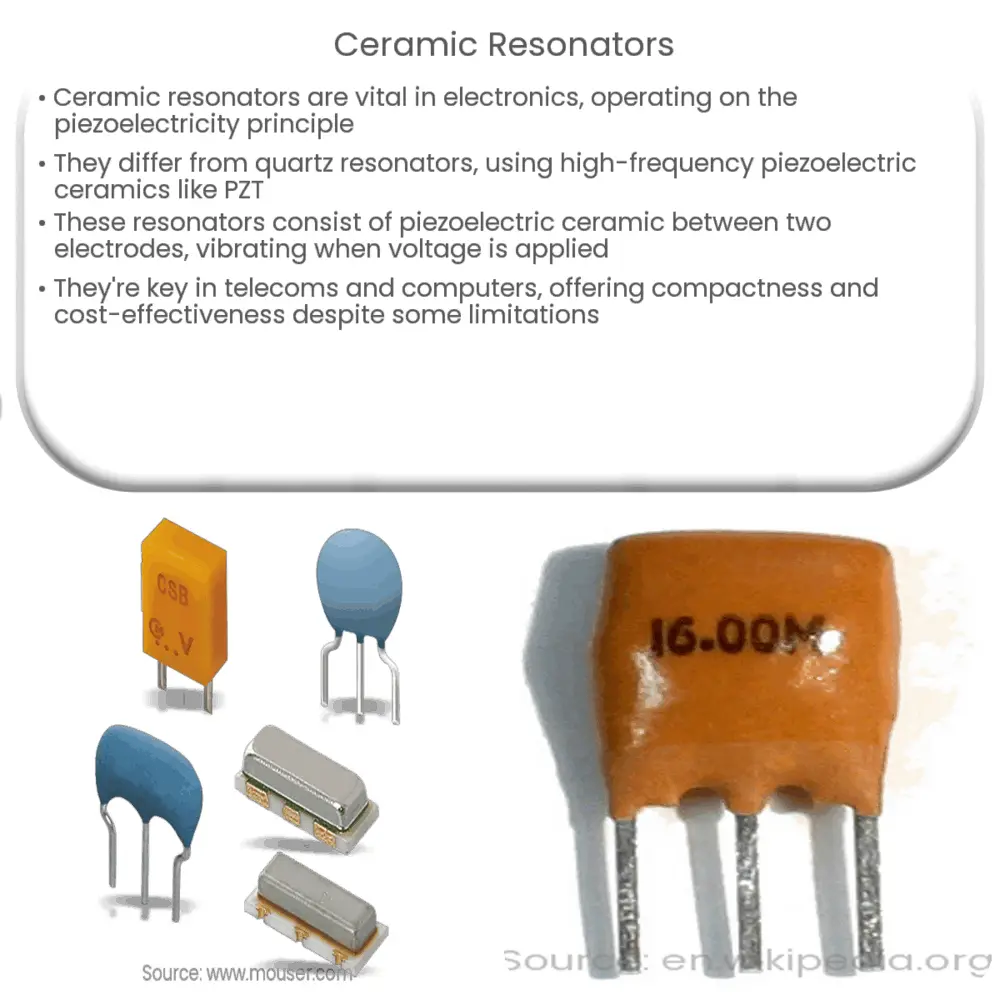Explore the world of ceramic resonators, their structure, working principles, applications, advantages, limitations, and future prospects in our comprehensive guide.

Introduction to Ceramic Resonators
Ceramic resonators are integral components in a wide array of electronic devices. They operate based on the principle of piezoelectricity, a phenomenon that allows certain materials to generate an electric charge in response to mechanical stress.
The Basics of Ceramic Resonators
A ceramic resonator is essentially a frequency control device that is similar to, yet distinct from, a quartz crystal resonator. One of the key differences is that ceramic resonators use high-frequency piezoelectric ceramics, usually in the form of lead zirconate titanate (PZT). This is the material that generates an electric charge when mechanically stressed or deformed.
Structure and Working Principle
Each ceramic resonator is typically composed of a piece of piezoelectric ceramic material sandwiched between two metal electrodes. The electrodes and ceramic form an oscillator circuit. When an alternating voltage is applied across the electrodes, the piezoelectric ceramic changes shape at the same frequency, causing it to resonate.
- The Structure of Ceramic Resonators: Ceramic resonators are composed of a disk or a plate of piezoelectric ceramic material, two electrodes, and a resonator cap. The ceramic material is the main component that carries out the oscillations. The electrodes are used to apply an electric field to the ceramic material, while the resonator cap ensures the stability of the resonations.
- How They Work: The application of an electric field causes the ceramic material to deform or oscillate. The oscillations result in mechanical stress that, in turn, generates an electric charge. This process of generating an electric charge by applying mechanical stress to a piezoelectric material is called the direct piezoelectric effect.
Applications of Ceramic Resonators
Ceramic resonators are employed in numerous devices and applications thanks to their excellent frequency stability, large Q factor (a measure of a resonator’s quality), and small size. They serve as frequency control and timing devices in a variety of applications including telecommunications, broadcasting, computers, and more.
- Telecommunications: In the telecommunications industry, ceramic resonators are used for frequency control in devices such as mobile phones and wireless communication systems.
- Computers: Ceramic resonators are integral to computer systems. They are utilized in the clock circuits of microprocessors and other digital logic circuits to provide timing signals.
Advantages and Limitations of Ceramic Resonators
While ceramic resonators offer a host of advantages, they are not without their limitations, and the choice between them and other frequency control devices depends on the specific requirements of a given application.
- Advantages: Ceramic resonators have a host of benefits. They have a high Q factor and are stable across a broad range of temperatures, making them suitable for applications in challenging environments. They are also compact, making them ideal for devices where space is a constraint. Furthermore, they are generally cheaper and more robust than quartz crystal resonators, which makes them an economical choice for many manufacturers.
- Limitations: Despite their advantages, ceramic resonators do have some limitations. Their frequency accuracy is typically lower than that of quartz crystal resonators. They are also more susceptible to aging effects and changes in temperature, humidity, and pressure.
Future Prospects
The demand for ceramic resonators is expected to rise in the coming years. This is largely due to the increasing miniaturization of electronic devices and the need for robust and reliable frequency control solutions. Research is also underway to develop ceramic resonators with improved performance characteristics, including better frequency accuracy and stability.
- Miniaturization: As devices continue to shrink in size, the demand for compact components like ceramic resonators will only increase.
- Improved Performance: Research is focused on improving the frequency stability and accuracy of ceramic resonators, as well as their resistance to environmental factors. These advancements will further enhance the utility of ceramic resonators in a range of applications.
Conclusion
In conclusion, ceramic resonators are indispensable components in today’s digital world. Their ability to provide stable frequencies in a compact and cost-effective package makes them integral to a vast array of applications, from telecommunications to computing. While they do have limitations, ongoing research and development efforts promise to improve their performance and expand their use in the future. Understanding the working principles, advantages, and limitations of ceramic resonators is crucial for those involved in electronics design and manufacturing.

